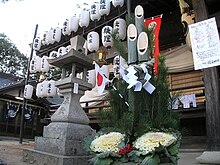This article needs additional citations for verification. (November 2015) |
A kadomatsu (門松, "gate pine") is a traditional Japanese decoration as yorishiro of the New Year placed in pairs in front of homes to welcome ancestral spirits or kami of the harvest.[1] They are placed after Christmas until January 7 (or January 15 during the Edo period) and are considered temporary housing (shintai) for kami. Designs for kadomatsu vary depending on region but are typically made of pine, bamboo, and sometimes ume tree sprigs which represent longevity, prosperity and steadfastness, respectively.[2] "The fundamental function of the New Year ceremonies is to honor and receive the toshigami (deity), who will then bring a bountiful harvest for farmers and bestow the ancestors' blessing on everyone." After January 15 (or in many instances the 19th) the kadomatsu is burned to appease the kami or toshigami and release them. The kadomatsu is included in Unicode as U+1F38D 🎍 PINE DECORATION.[3]

Construction and placement
The central portion of the kadomatsu is formed from three large bamboos, though plastic kadomatsu are available. Similar to several traditions of ikebana (Japanese flower arrangement), the bamboos are set at different heights and represent heaven, humanity, and earth with heaven being the highest and earth being the lowest. Some kadomatsu place the humanity and earth shoots at the same height. After binding all the elements of the kadomatsu, it is bound with a straw mat and newly woven straw rope. Kadomatsu are placed in pairs on either side of the gate, representing male and female.
Gallery
-
Kadomatsu of East Japan (Kantō region)
-
Kadomatsu of West Japan (Kansai region)
-
Three miniature kadomatsu being sold outside for 700 Yen each
-
Kadomatsu
-
A small kadomatsu in a store
-
A kadomatsu in Kyoto style
-
Kadomatsu in the style of the Edo period
-
A fancy kadomatsu
-
Kadomatsu in Kamakura